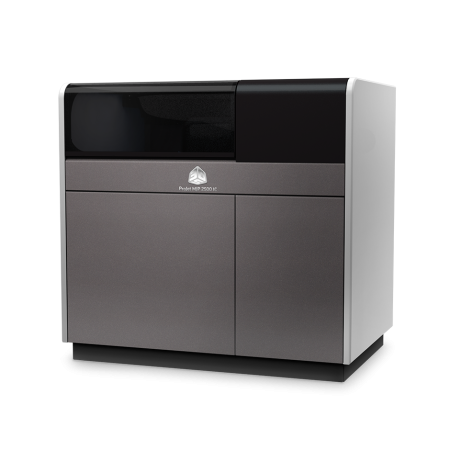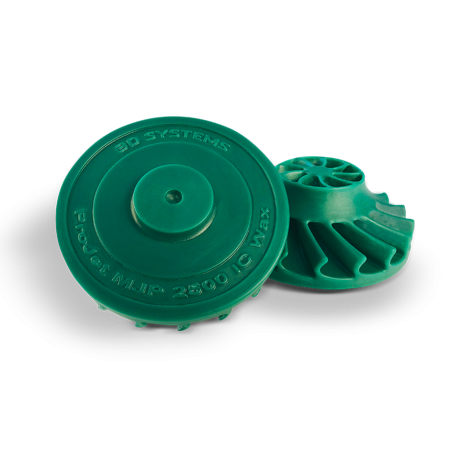Established in 1966, Protocast-JLC is a one-stop precision investment casting manufacturer for a variety of quality- and innovation-oriented industries, including aerospace, energy, communications, medical, and military, among others. The full-service investment casting foundry has built a strong reputation among its customers for its ability to tailor production to meet customer demands, and the addition of a ProJet® MJP 2500 IC investment casting printer by 3D Systems has contributed to that reputation. In addition to helping the foundry deliver intricate, high-quality investment casting patterns faster, the flexibility of digital production has enabled Protocast to win more customers by providing a cost-effective way to fulfill orders of any volume.
Challenge
Reduce the time and cost of investment casting patterns for intricate production parts.
Solution
3D printing wax investment casting patterns with 3D Systems ProJet® MJP 2500 IC and VisiJet® M2 ICast material
Results
- Reduce lead time on cast parts from 12 to 13 weeks to same-week delivery;
- Grow business through ability to offer flexible production quantities on high quality cast parts without tooling;
- Improve customer communication and job quoting with near-instant scale model production.
Intricate, high-quality 3D printed investment casting patterns, delivered fast
Protocast specializes in the pouring of aluminum, steel, and copper-based investment casting alloys and has built a reputation among its customers for successful casting outcomes on unique parts that would be impossible to tool and injection mold. These parts include thin walls and intricate details. For example, amplifier horns on satellites, which have “hyper-thin walls” that could not be done any other way, according to Chris List, Business Development Manager at Protocast.
Protocast has built this reputation through the incorporation of additive technologies for 3D printing casting patterns. Foundry owner John List began incorporating additive technologies through third-party providers as a way to help his customers achieve more intricate parts and bypass the design limitations typical of conventional casting pattern production. However, outsourcing pattern production made it challenging for Protocast to fully set and control delivery schedules, which typically hovered around twelve to thirteen weeks when relying on a vendor to supply the pattern.
To improve self-sufficiency, predictability, and costs, Protocast purchased 3D Systems’ ProJet MJP 2500 IC, to produce castable 3D printed parts in-house. Since integrating its own 3D printer, lead time from order to delivery has shrunk from multiple months to same-week delivery.
A streamlined workflow from CAD to casting
According to Chris, who is Protocast’s primary operator of the ProJet MJP 2500 IC, 3D Systems’ digital foundry solution has helped the foundry remove steps from its previous process, particularly in aluminum castings and for detailed parts. Using conventional methods, some of the parts Protocast produces would require two to four tools to produce. “Now, we can get something printed and in someone’s hand in a week if we have to,” says Chris.
The ProJet MJP 2500 IC is a 3D printing solution for the digital foundry that uses 100% RealWax™ investment casting wax to deliver fast and cost-effective, tool-less wax patterns. By eliminating tooling, the ProJet MJP 2500 IC reduces the time and expense of transitioning from a design to a cast part, and 3D Systems’ VisiJet® M2 ICast material, a paraffin-based wax, integrates seamlessly into standard investment casting workflows. It is now possible to produce high quality cast parts in a fraction of the typical time.
The ProJet MJP 2500 IC has been a great tool for Protocast, particularly in steel castings, and performs identically to the foundry’s existing processes. Chris says the foundry is getting reliable casting results with its in-house 3D printed patterns simply by calculating shrink rates and applying them to the geometry in 3D Sprint®.
“Our customers have responded very well to these parts, and I think the time and cost savings enabled by this process contribute to that response,” Chris says. “Taking a drawing and turning it into metal has traditionally been a drawn-out process. The immediate satisfaction of holding a physical part is awesome.”
Transitioning to the digital foundry
Protocast reports an easy transition to the digital foundry and is now able to defy conventional limitations on casting pattern production in terms of both complexity and speed. Operationally, the main difference between life before the ProJet MJP 2500 IC and life with it, is that the foundry no longer needs to outsource casting patterns to other facilities. “We were used to using 3D models for our projects, and the software is easy to use,” says Chris, who uses 3D Systems’ 3D Sprint® software that comes with the ProJet MJP 2500 IC primarily for splitting patterns and engineering. “It’s just really easy. You can’t put it any other way,” he says.
As for the 3D printer itself, Chris says it has proven to be a valuable tool for more than final pattern production: “The machine hasn’t stopped running since we got it,” says Chris. In addition to production patterns, Protocast uses its ProJet MJP 2500 IC to produce scaled-down versions of customer parts to aid in both quoting and sales. “This capability has been very beneficial because it shows our customers we are able to get started right away, and it also gives us common ground to have engineering discussions as needed.”
Faster time to parts, high quality casting patterns, and enhanced customer communication are all great advantages. The biggest advantage of all, however, has been growth: “I think the ProJet MJP 2500 IC has opened up a new customer base for us,” says Chris. “Before, we weren’t able to accommodate as many jobs that needed flexible production quantities. Now, we don’t have to wait for any tooling and we don’t have to add twenty thousand dollars in tooling to the quote we give our customers.”
Reliable access to casting
Given the success of integrating the ProJet MJP 2500 IC into its workflow, Protocast is now considering the purchase of additional machines to continue growing its capacity and providing its customers with enhanced service.
“Managing how we’re going to produce parts is a huge deal for us and our customers,” says Chris. “The ProJet MJP 2500 IC has given us a reliable solution in that regard, and that is in addition to its ability to help us with near-instant parts-in-hand and fast quoting. It really is an amazing tool to have.”
“Good toolmakers are hard to find,” says List, “but we’ve found one with this machine.”

